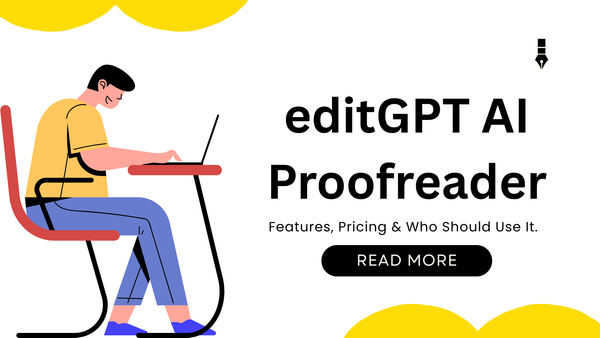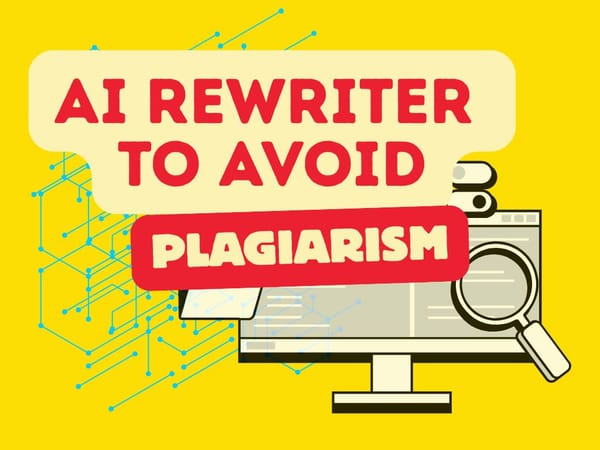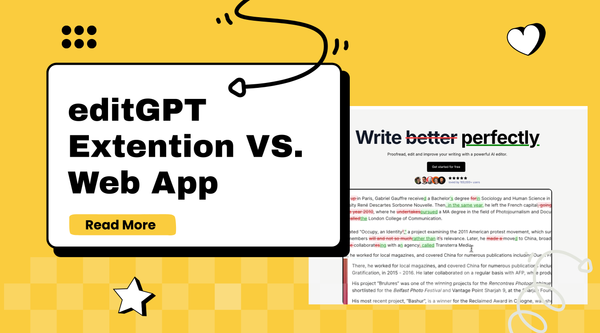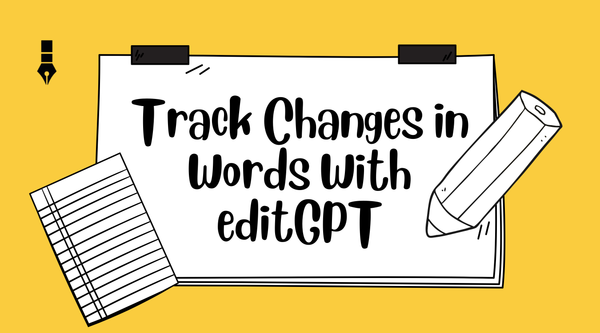Scribbr vs editGPT: Best Proofreading Experiment
Scribbr AI detector and Scribbr paraphrase tool has been around for a while. But how does it compare with one of the most intelligent AI proofreaders today? We did an experiment to find out.

Scribbr has long become something of a household name, especially among university students and researchers. That’s all thanks to its in-depth plagiarism checker and proofreader.
On the other hand…
…editGPT offers human-like AI proofreading and editing like no other that it’s now considered one of the most intelligent AI proofreaders today.
To find out, we put both tools to the test in an editing experiment.
The results might surprise (and help) you.
Let’s dive in.
Testing methodology
I used a 2,000-word academic-style essay and ran it through both editGPT and Scribbr. I intentionally included grammar issues, awkward phrasings, and even a few citation errors to really test how far these two AI proofreaders can go.
I also chose a psychology research essay because it has complex sentence structures and references.
The goal?
To find out which one gives more value, depending on your needs: speed, quality, cost, and accuracy.
editGPT AI proofreader results
After running the 2,000-word psychology research essay through editGPT’s AI proofreader, the result was strikingly intelligent… and fast at that.
The AI tool gave me the result in under a minute, showing the tracked changes so I could understand what had been changed, and gave me options to accept or reject the suggestions.
Nuance matters so much when it comes to academic or any industry-specific writing. And this is what I also especially looked out for in this experiment.
And this is what stood out with editGPT the most.
It’s very notable how it understood the context, tone, structure, and meaning of the essay I used.
Take this part of the essay, for example.
“Suppressing emotions might seem like control, but over time, it builds pressure beneath the surface.”
The other proofreading tool (and the other two I’ve used to be sure) flagged the phrase “builds pressure beneath the surface” as vague or metaphorical. editGPT, however, left it untouched, clearly recognizing it as a deliberate analogy.
Instead, it improved the next sentence to clarify the psychological mechanism behind emotional buildup, reinforcing the original point without compromising the writer’s voice.
And that’s what editGPT does best, preserving your tone and voice.
Because of this, this human-like AI proofreader would also suggest better wordings or alternatives that will make your text sound much better, with a more intuitive but authoritative flow.
Take this part, for instance.
“Avoidant individuals might act distant, but it’s not about disinterest. It’s often a protective mechanism shaped by early caregiving.”
While other tools focused on “it’s not about disinterest,” editGPT preserved it, sensing the balance between academic insight and reader relatability.
Instead, it restructured the sentence for better rhythm and flow without over-formalizing it. That kind of contextual understanding is what makes it feel like a true collaborator, not just a checker.
As a bonus…
editGPT’s user interface is also very clean and distraction-free. Despite its very advanced features and intelligence, it’s still very intuitive. That makes it great not just for seasoned writers or people who are already used to AI tools, but also for beginners and first-timers.
Overall, editGPT nailed the proofreading arena. Its contextual editing intelligence feels like a human (or much better, sometimes!) that understands your purpose and intention without you having to explain it.
It just gets you.
It edits with intelligence, speed, and a real respect for your tone and meaning. It’s easily one of the most human-like and context-savvy AI proofreading tools out there.
Scribbr proofreading results
Scribbr has positioned itself as one of the best-known academic writing assistants today. That said, it’s expected that it’s more focused on formal tone, clarity, and citation accuracy.
This AI tool performed well when I used it on essays requiring APA formatting and technical consistency.
In a part of the essay that discusses Pavlovian responses, the sentence I had was: “The dog learned to expect food when it heard the bell.”
Scribbr refined this into:
“The conditioned stimulus of the bell led to anticipatory salivation, illustrating classical conditioning.”
This edit shows a strong academic intuition, incorporating discipline-specific phrasing while eliminating a colloquial tone. This transformation is exactly the kind of polish that university students or researchers might need before submission.
Technically speaking…
Scribbr does more than just correct grammar. Just like editGPT, it also assesses sentence structure and flags awkward phrases and repetitions.
However, Scribbr isn’t without limitations.
As mentioned earlier, one of its recurring drawbacks is its rigid preference for overly formal wording. As a result, it sometimes strips the text of its original tone and voice. This isn’t very recommendable if you’re working on a persuasive or argumentative essay.
Take this text, for example.
“CBT helps people understand how thoughts influence actions.”
It was edited into:
“Cognitive Behavioral Therapy facilitates comprehension of cognitive-affective patterns impacting behavioral outcomes.”
While technically accurate, the revision veered toward verbosity. It’s fine for a dissertation, but arguably too dense for an undergraduate essay.
Another technical downside is that Scribbr struggles to adapt to different stylistic intentions. For instance, if an author aims for a reflective or narrative tone, which is common in qualitative psychology reports, its AI often misinterprets this as "informal" and replaces it with academic jargon.
Additionally, it’s less tolerant of sentence fragments that are intentionally used for rhetorical effect or emphasis, a style sometimes found in behavioral science discussions.
Speed-wise, Scribbr took less than 3 minutes to proofread the 2,000-word essay.
Its interface is clean and user-friendly, just like editGPT. You just drag and drop your document for it to be proofread. It’ll then generate a suggestion, which looks just like most document editors today, with color-coded explanations in the sidebar.
Just also take note that you won’t be able to freely edit your text within the document while viewing changes in real time. You could find yourself switching between tabs or downloading different versions.
While it’s functional, this workflow can feel more rigid compared to the more streamlined editGPT.
Other features
editGPT
While editGPT shines with its intelligent proofreading capabilities, it doesn’t stop there. It also has other features that feel thoughtful and were designed to make your overall workflow easier and your writing genuinely you while being polished.
- Academic mode: It recognizes common academic phrases and structures while helping with citation clarity, which is perfect for students, researchers, or thesis writers.
- Project mode: Planning a long-term writing project? editGPT can track your style and content preferences across multiple sessions. Whether you're working on a dissertation, a white paper, or book chapters, Project Mode preserves your voice, structure, and pacing preferences, allowing you to avoid starting from scratch each time.
- Industry-specific writing: From legal briefs to UX case studies, editGPT tailors its suggestions to your specific field. It recognizes the jargon, formats, and tone variations expected in different industries, making it especially useful for professionals writing reports, presentations, or emails.
- Multilingual capabilities: It has more than 80 languages and 20 business languages.
- Integration with Microsoft Word: You can export your edit to MS Word and still see the tracked changes.
Scribbr
Scribbr’s primary focus is on academic writing, so it doesn’t have much of a suite of AI tools or modes here. But what it does, it does well.
- Plagiarism checker: This feature is what made Scribbr popular. It compares your work against a comprehensive academic database to identify potential matches. Although it is not free, it provides valuable reassurance for students preparing high-stakes submissions such as dissertations or final-year theses.
- Language support: Scribbr supports editing in English (US, UK, AU) and several European languages. However, switching between them can be somewhat clunky.
Scribbr vs editGPT FAQs
What is Scribbr?
Scribbr is a tool and service that helps students and researchers improve their academic writing. It primarily offers proofreading, citation assistance, and plagiarism checking, with a strong emphasis on academic standards, including APA, MLA, and Chicago.
Is Scribbr AI detector accurate?
Scribbr does not offer a dedicated AI detector. Instead, its tools primarily focus on grammar, structure, and referencing. If you need to scan for AI-generated content, you will need a separate tool specifically designed for that purpose.
Is Scribbr legit?
Yes, it’s a legitimate company. Scribbr was launched in 2012 and gained popularity around 2017, and is used by students worldwide, particularly for proofreading final papers and correcting citations.
Is Scribbr plagiarism checker good?
It performs its function effectively. The checker compares your work to a large database, flagging similarities that may be problematic in academic settings. It's particularly useful for identifying unintentional overlaps.
Does Scribbr use Turnitin?
Yes, Scribbr’s plagiarism checker is powered by Turnitin’s technology. This means it analyzes your paper using Turnitin’s extensive database, but through a student-friendly interface that doesn’t store your document in Turnitin’s system.
Is Scribbr the same as Turnitin?
Not quite. Turnitin is the original engine, while Scribbr acts as a student-friendly layer on top. You benefit from the same detection capabilities, but your paper isn’t permanently stored as it would be if submitted directly through Turnitin at your school.
Is Scribbr plagiarism checker safe?
Yes, it’s safe to use. Scribbr doesn’t save your document in Turnitin’s institutional database, which helps prevent future false positives for self-plagiarism.
Is Scribbr reliable?
It depends on your needs. For citation fixes and grammar corrections, it's fairly reliable. However, if you're looking for in-depth content editing or customized improvements based on your topic, it may feel limited.
Is Scribbr accurate?
It’s generally accurate, particularly regarding grammar and formatting. However, when writing about a complex subject like psychology, you may find that it does not always convey the nuances of academic tone or discipline-specific language.
Is Scribbr safe?
Yes, it is safe in terms of privacy and document handling. Files are encrypted and not stored in public databases.
Is Scribbr plagiarism checker accurate?
Generally, yes. Since it is built on Turnitin's system, it has access to a robust academic database. However, it may occasionally flag quotes or common phrases, so interpreting the results carefully is essential.
Is Scribbr citation reliable?
It's decent for the basics. Scribbr's citation generator effectively handles standard styles like APA and MLA, but you might want to double-check less common source types.
How accurate is Scribbr plagiarism checker?
It’s one of the most accurate tools available to students. While it flags a wide range of matches, it’s ultimately your responsibility to distinguish between unintentional similarity and commonly used phrases.
Is Scribbr good?
It’s a good choice if you need assistance with academic writing, especially for proofreading or citations. However, if you're looking for real-time editing suggestions or advanced AI tools, you may find other platforms to be more versatile.
Is Scribbr a reliable source?
If you're wondering whether Scribbr can be cited like a journal or academic article, the answer is no. It’s more of a helpful service than a source of scholarly information. On the other hand, it’s reliable for grammar, citations, and final checks.
Final thoughts
After using both tools side by side for weeks, it’s clear that Scribbr excels in basic academic proofreading. It's a reliable and well-known choice for students seeking assistance with polishing citations and catching surface-level grammar errors in their essays.
However…
…when I needed more nuanced editing, real-time suggestions for convenience, and the ability to adapt or maintain my tone, voice, and intent, editGPT proved to be immensely helpful.
It became my full-fledged writing assistant, with the added benefit of focusing on academic and industry-specific writing and editing.
When considering value for money…
…the choice is straightforward. editGPT offers more than what you pay for, thanks to its comprehensive suite of writing and proofreading tools. With editGPT, you won’t need any other tool. It has everything necessary for your workflow.
Recommended Reading
Video review: This AI Text Editing Tool Is FLAWLESS!
Best AI Proofreader Tools of 2025 (Tested for Accuracy, Speed & Tone) editGPT vs Grammarly vs Quillbot: Which Writing Tool is Best?
The Best AI Proofreaders That Actually Work (Free & Paid)
Review: Wordtune Editor vs editGPT
Review: Grammarly vs editGPT
Review: ProWritingAid vs editGPT
Review: Hemingway Editor vs editGPT



